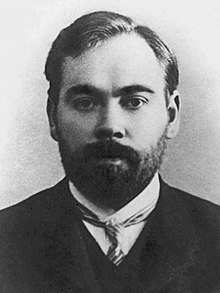Workers' Truth
Workers' Truth Рабочая Правда | |
|---|---|
| Founded | September 1921 |
| Dissolved | December 1923 |
| Split from | Communist Party of the Soviet Union |
| Preceded by | Proletkult |
| Newspaper | Workers' Truth |
| Ideology | Left communism |
| Political position | Far-left |
| Part of a series on |
| Left communism |
|---|
 |
The Workers' Truth (Russian: Рабочая Правда, romanized: Rabochaya Pravda) was a Russian socialist opposition group founded in 1921.[1] They published a newspaper with the same name, Workers' Truth, which first appeared in September 1921.[2]
The Workers' Truth considered that the
Its main activists were arrested in September 1923—the group's activity being largely suppressed thereafter—and expelled from the Communist Party in December of the same year.
Ideas
Their programmatic statement (the "Appeal/Message to the Revolutionary Proletariat and to All Revolutionary Elements Who Remained Faithful to the Struggling Working Class").
They argued that during
The group considered it necessary to create a
- Freedom of expression and associationfor "revolutionary elements of the proletariat";
- Fight against administrative arbitrariness;
- End of the "fetish" of reserving the right to vote for workers;[6]
- Defense of the economic interests of the labor laws;
- Good relations between the reactionary" France;
- Support for the national bourgeoisie of countries like China, India or Egypt against colonialism.
Origins
The intellectual roots of the Workers' Truth are most likely in the Proletkult movement, and above all in the manifesto of the "Collectivists", published in 1921 by some elements of this movement (and possibly also linked to the Workers' Opposition), warning of the danger of bureaucratic intelligentsia becoming a ruling class in a capitalist state.[7]
The Workers' Truth activists were mostly students[8] and from the "red" academies, that is, the higher education institutions created for the purpose to form the intellectuality of the new regime.[9] Nevertheless, they argued that promoting cultural work among industrial workers was more important than funding universities, as these would be frequented by ex-workers who would join the technocrats.[10]
Relationship with other opposition groups
The Workers' Truth considered that the
For its part, the Workers' Group, led by Gavril Myasnikov, in its manifesto, accused the Workers' Truth of in practice (by saying that Russia was already capitalist) accepting and promoting the restoration of capitalism, and limiting the working class to fight only for better salaries.[11]
Repression


In August 1923 a wave of strikes spread across Russian industrial centres, sparked off by the
Fearing that dissident communist groups like Workers' Truth or the Workers' Group could capitalize on the labor unrest to gain support among the working class,
In December 1923, Fanya Samoilova Shutskever, Efim Rafailovich Shul'man, Vladimir Markovich Khaikevich, Yakov Grigorevich Budnitsky, Pauline Ivanovna Lass-Kozlova, Oleg Petrovich Vikman-Beleev, and Nellie Georgievna Krym were identified as the leaders of Workers' Truth and expelled from the Communist Party[19] (at least Fanya Shutskever and Pauline Lass-Kozlova would be reinstated in the party, in 1926[20] and 1927,[6] respectively; Shutskever would be arrested again in 1938).[20]
With the arrests of September 1923, the Workers' Truth was effectively dissolved.[21]
See also
References
- ISSN 1570-1522.
- Carr, Edward Hallett (1969). A History of Soviet Russia: The interregnum, 1923-1924. Penguin Books. p. 89.
- OCLC 1261928253. Retrieved 4 February 2018.
- ^ a b c d Apelo do grupo Verdade Operária 1923
- JSTOR 40870666. Retrieved 23 February 2018.
- ^ a b Pirani 2008, p. 127
- ^ Halfin 2000, p. 378
- ^ Halfin 2000, p. 379
- ^ Pirani 2008, p. 143
- ^ Halfin 2000, p. 381
- OCLC 906298570.
- JSTOR 129715. Retrieved 28 December 2017.
- ^ Pirani 2008, pp. 199–203
- ^ Pirani 2008, p. 203
- ISBN 9781859844465. Retrieved 23 February 2018.
- ^ Schapiro, Leonard (1971). The Communist Party of the Soviet Union. Vol. 745 (2nd ed.). Vintage Books. pp. 280–281.
- ^ Pirani 2008, pp. 195, 204
- ISBN 978-0-226-45412-2. Retrieved 23 February 2018.
- ^ "Postanovlenie TsKK po delu gruppy Rabochaya Pravda". Pravda (in Russian) (296). Moscow. 30 December 1923.
- ^ a b Pirani 2008, p. 250
- ^ Pirani 2008, p. 195
Bibliography
- "Vozzvanie gruppy Rabochaya Pravda". Sotsialisticheskii Vestnik (in Russian). 49 (31). Berlin: 12–14. 31 January 1923.
- Halfin, Igal (2000). "The Ultra-Left: Workers' Truth". From Darkness to Light: Class, Consciousness, and Salvation in Revolutionary Russia. Pitt Series in Russian and East European Studies. ISBN 9780822972044. Retrieved 4 February 2018.
- Pirani, Simon (2008). The Russian Revolution in Retreat, 1920–24: Soviet workers and the new communist elite (PDF). BASEES/Routledge Series on Russian and East European Studies. Vol. 45. ISBN 9781134075508.
External links
- Petrov, Igor (1 January 2014). "Группа Рабочая правда, Материалы". Rabkrin (in Russian). Retrieved 7 January 2018.
- Partial English Translation of the "Appeal..."
- Full Portuguese Translation of the "Appeal..." (in Portuguese)
